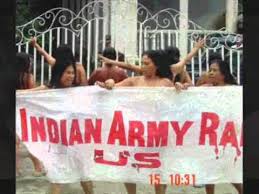Choosing Satyagraha Over Spectacle
NONVIOLENCE, 2 Feb 2015
31 Jan 2015 – This Republic Day had two sets of tableaux, one enacted on Rajpath, and the other more elaborate as the tableau of security. Yet, as spectacles, Mr. Obama will be forgotten while the satyagrahi’s acts of conscience and courage will prompt us to rethink history.
The ritual of political spectacles creates its own frenzy of anticipation. U.S. President Barack Obama’s visit to India was expected to create a sense of magical politics before it faded into banality. For all the hysteria of expert commentary, no new regime of intellectual property is going to emerge, and no nuclear deal will have the qualities of transparency both sides will demand. But there was a second piece of drama which was relevant to the themes of the visit. Mr. Obama was searching for a new compact to fight terror. The second event challenged the security discourse he was urging by talking of peace in a different language. This was Irom Sharmila’s decision to continue her fast after the High Court had cleared her of charges of suicide.
 Sharmila’s fast, one of the classic acts of satyagraha in history, has often been read as a local event. For all its drama, it is seen as a footnote to the problems of the so-called North East, a local struggle in Manipur. Yet, politics has a way of transforming itself from a local anecdote to a national symbol. Sharmila’s years of fasting, protesting against the Armed Forces (Special Powers) Act (AFSPA) is relevant for a world which is combating terror. Terror today is not an act confined to rebels and insurgents. Terror is also a part of the policy of the state. AFSPA, formalised by Parliament in 1958, has destroyed the normalcy of Manipur. Sharmila’s fast began as a simple, naive act of protest by a young girl who decides to refuse food till AFSPA is repealed. She was protesting against the rape and murder of Manipuri women by an Army which used the law to commit atrocities with impunity. Over the years, the simple message of courage has made Sharmila’s act, a major message of non-violence today.
Sharmila’s fast, one of the classic acts of satyagraha in history, has often been read as a local event. For all its drama, it is seen as a footnote to the problems of the so-called North East, a local struggle in Manipur. Yet, politics has a way of transforming itself from a local anecdote to a national symbol. Sharmila’s years of fasting, protesting against the Armed Forces (Special Powers) Act (AFSPA) is relevant for a world which is combating terror. Terror today is not an act confined to rebels and insurgents. Terror is also a part of the policy of the state. AFSPA, formalised by Parliament in 1958, has destroyed the normalcy of Manipur. Sharmila’s fast began as a simple, naive act of protest by a young girl who decides to refuse food till AFSPA is repealed. She was protesting against the rape and murder of Manipuri women by an Army which used the law to commit atrocities with impunity. Over the years, the simple message of courage has made Sharmila’s act, a major message of non-violence today.
Terror and satyagraha
Terror today dominates state politics, immobilising democracies which are addicted to the security discourse. When the state mirrors the violence of the terrorists, a political impasse is born. Sharmila shows that satyagraha might be an answer to the indignity of terror. Satyagraha can fight terror and shame it into civility. Let us first examine the contrast.
Terror is contemptuous of the body, indifferent to the suffering of the victim. Satyagraha uses the body as the vehicle of truth and uses suffering to create compassion. It offers the dignity of vulnerability to the indifference of terrorism.
Terror paralyses through anonymity. It is always masked. Satyagraha is always a face which seeks to communicate. Terror paralyses discourse while satyagraha opens up conversation. A Gandhi would always talk to his oppressors while IS would at most “telegram” its ownership of the act of violence. Satyagraha seeks the ethics of responsibility. Terror owns the act of violence but disowns the responsibility for it.
Terror emphasises invulnerability. Satayagraha begins from vulnerability. Terror paralyses agency and satyagraha seeks to revive it. Watching Sharmila, one senses the vulnerability of a fragile woman and yet the strength of agency which has survived over decades.
Terror creates shock but no surprise. It fuses politics and technology into repetitive acts of cannibalising bodies. The satyagrahi is constantly inventing. Terror destroys normalcy while the satyagrahi seeks to restore normalcy and in pondering over its delights. Irom Sharmila insists that when AFSPA is repealed, she will marry a man she loves and live an ordinary life.
The satyagraha speaks truth to power while terror seeks to challenge power through violence. The women of Manipur know that insurgence is no answer to development. They are not looking for mock heroics but the ordinariness and everydayness of life and its rituals.
Satyagraha seeks justice. Terror, at the most, can speak the language of revenge. In fact, terror depoliticises politics by invoking the redundancy of security discourse, while satyagraha is an invitation to politics, to its constant reinventions. The satyagrahi summons speech while terror invites the constant noise of violence.
In terms of drama, satyagraha is the politics of theatre, but terror has no real sense of dialogue, drama or spectatorship. The protests of the women of Manipur standing naked before the Assam Rifles headquarters saying, “Rape us too”  conveys drama while bin Laden, for all the publicity, conveys no sense of speech, no inventiveness of language, no sense of surprise. The redundancy and the excess of terror elude drama. Terror destroys storytelling while satyagraha unfolds as an epic story.
conveys drama while bin Laden, for all the publicity, conveys no sense of speech, no inventiveness of language, no sense of surprise. The redundancy and the excess of terror elude drama. Terror destroys storytelling while satyagraha unfolds as an epic story.
The message of Irom Sharmila is the message of Václav Havel, of Mahatma Gandhi, of Martin Luther King; that out of vulnerability can come the agency which emancipates, which understands the other as it battles him.
No understanding
Our terrorists and our security discourses seek only dominance and control, not understanding. The discourse that Mr. Obama spouts shows little understanding of the evils enacted by the U.S. Narendra Modi shows little sense of the suffering of the North East. In fact the term North East is itself a violence to the diversity of communities in the area. The women of Manipur are asking for the gift of normalcy, the right to everydayness which allows a citizen to pursue life and liberty.
In fact, my mind was toying with the idea that Obama-Modi would enact their lifeless politics on Republic Day. Their battle hymn of the republic seeks deals about nuclear energy, defence and intellectual property. Think of these negotiations along with the tableaux of militarism that the Indian state presented on January 26. This Republic Day had two sets of tableaux, one enacted on Rajpath but the more elaborate one is the tableau of security, the seven rounds of security cordons that protected Mr. Obama. At this moment one realises the voyeurism of India in seeking the same securitarian pomposity as the U.S. Yet, as spectacles, Mr. Obama will be forgotten while Sharmila’s acts of conscience prompt us to rethink history.
Sharmila too talks of development but it is the story of village and family, of craft and biomass societies confronting the new developmentalist state.
New kind of democracy
Security, and its sibling, terror, create spectacles while satyagraha unfolds as a drama. Imagine for a moment that one narrowed such drama to a spectacle of tableaux on Republic Day. Imagine a Republic Day without the military, the uniforms and the preening aircraft. Think of our satyagrahis as a tableau of events beginning with Gandhi and Ghaffar Khan. Add to it Mahasweta Devi, the Bengali writer, talking of bonded labour like a sad old aunt. Think of Aruna Roy leading the protest of the poor of Rajasthan, demanding a right to information. Imagine the displaced survivors of the Narmada Dam sitting immersed in water to remind India that development is a kind of amnesia. Think of Ela Bhatt of SEWA claiming that world peace begins with women’s work. Add to it the protest of Manipur and of Irom Sharmila sitting quietly, giggling over one of her drawings and surrounded by security guards. Such tableaux make words like security, development, sovereignty empty. They seek to create a new kind of democracy.
The juxtaposition of two news events this week showed us the possibility of two kinds of politics. The reports of Irom Sharmila hardly extended to a paragraph; an indifferent footnote in some newspapers. The Modi-Obama serenade, with its chorus of commentary, swallowed our newspapers, where even attention went into First Lady Michelle Obama’s dress. I do not think there was a photograph of Irom in any newspaper. I think The Telegraph was possibly the one newspaper that reported the struggle in detail.
As I sat and wrote this article on a cold winter’s day, while roads all over Delhi were blocked in a display of efficiency, I wondered who would survive as history; who would be the greater exemplar of politics and the politics of hope that democracy creates.
Would it be Narendra Modi and his dreams of India as Prussian state? Was it Mr. Obama, the President, who promised so much and offered so little, desperate to create a few crumbs of history by clinching a nuclear deal with India? Or would it be Irom Sharmila and her craft of peace, seeking normalcy, an ordinariness in a society which prefers the state as a constant spectacle, and where politics is a continuous act of conspicuous consumption in terms of security, luxury and the pomposity of power? To me, the quietness of Sharmila wins over the noise of the Modi-Obama political machine.
As a satyagrahi, I am sure Sharmila would have liked to send them a greeting card, inviting them to come to Manipur. I think it is the Irom Sharmilas, the Mahasweta Devis and the Ela Bhatts who have to colour the imagination of India and take it beyond the triteness of state politics. The storyteller has to return to narrate these events, for what goes as news today is a travesty of peace and history.
____________________________
Shiv Visvanathan is a professor at Jindal School of Government and Public Policy.
DISCLAIMER: The statements, views and opinions expressed in pieces republished here are solely those of the authors and do not necessarily represent those of TMS. In accordance with title 17 U.S.C. section 107, this material is distributed without profit to those who have expressed a prior interest in receiving the included information for research and educational purposes. TMS has no affiliation whatsoever with the originator of this article nor is TMS endorsed or sponsored by the originator. “GO TO ORIGINAL” links are provided as a convenience to our readers and allow for verification of authenticity. However, as originating pages are often updated by their originating host sites, the versions posted may not match the versions our readers view when clicking the “GO TO ORIGINAL” links. This site contains copyrighted material the use of which has not always been specifically authorized by the copyright owner. We are making such material available in our efforts to advance understanding of environmental, political, human rights, economic, democracy, scientific, and social justice issues, etc. We believe this constitutes a ‘fair use’ of any such copyrighted material as provided for in section 107 of the US Copyright Law. In accordance with Title 17 U.S.C. Section 107, the material on this site is distributed without profit to those who have expressed a prior interest in receiving the included information for research and educational purposes. For more information go to: http://www.law.cornell.edu/uscode/17/107.shtml. If you wish to use copyrighted material from this site for purposes of your own that go beyond ‘fair use’, you must obtain permission from the copyright owner.